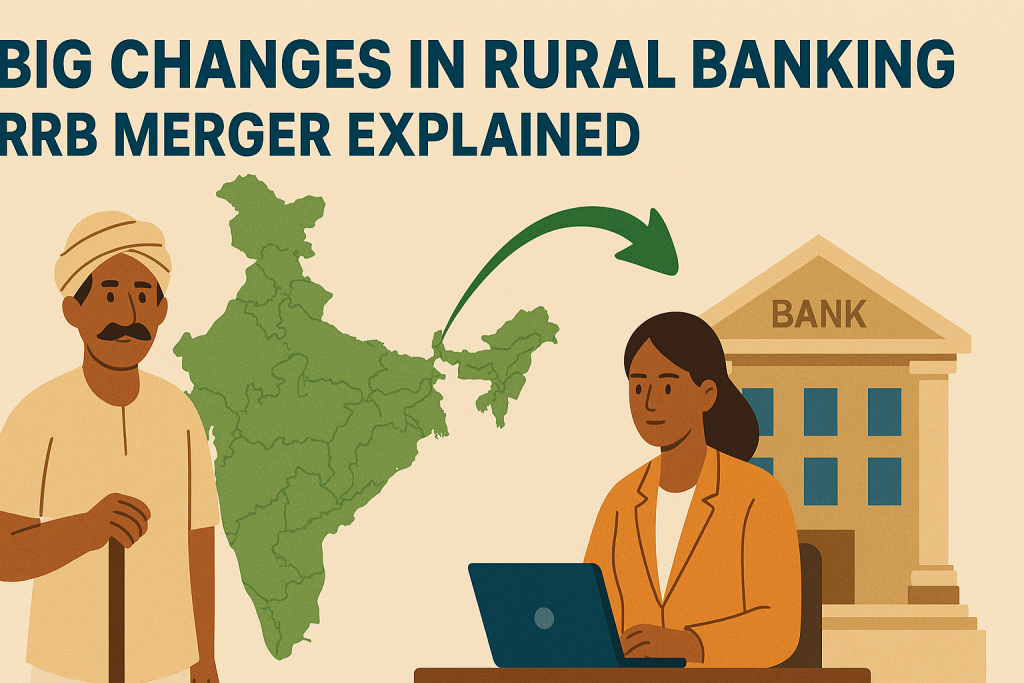Have you ever seen a farmer carefully planting seeds in his field? Every seed has the power to grow into something big. That’s exactly what is happening with India’s rural banking right now.
In April 2025, the Government of India planted a new seed for the future of rural banking. This change is not small. It touches the lives of millions of people living in villages — people who grow our food, run small shops, send their children to school, and dream of a better life.

This is the story of how India merged several small Regional Rural Banks (RRBs) into one large bank in many states. It’s a story of hope, growth, and a little bit of adjustment.
Let’s go step by step.
What are Regional Rural Banks (RRBs)?
Regional Rural Banks were created in 1975 to help rural India. Their job was simple — take banking to the villages. Bring money closer to the people who need it most.
Farmers, small shop owners, rural women, labourers, and daily wage earners — these were the people RRBs were designed for.
They offered loans for seeds, cattle, tractors, shops, houses, education — everything needed to build a better life.
But over time, there were 43 RRBs across India. Some were big. Some were very small. Some were doing well. Others were struggling with losses.
Running so many small banks was becoming difficult.
So, Why Did The Government Merge Them?
The answer is simple: To make rural banking stronger, smarter, and more efficient.
Here’s what was happening:
- Too many RRBs meant higher expenses.
- Some banks lacked new technology.
- Some had poor profits.
- Small banks had limited services.
- Customers had different rules in different places.
The solution? Merge them together.
→ One bank per state or region.
→ Stronger balance sheets.
→ Uniform rules and services.
→ Faster adoption of technology.
→ Easier management.
Think of it like this: Instead of many small boats struggling in a storm, India now has one large ship sailing strong.
Which Banks Got Merged and Where?
Here is a quick look at the major changes:
| State | New Bank Name | Banks Merged | Head Office Location |
|---|---|---|---|
| Andhra Pradesh | Andhra Pradesh Grameena Bank | 4 RRBs combined | Amravati |
| Bihar | Bihar Gramin Bank | Dakshin Bihar Gramin & Uttar Bihar Gramin | Patna |
| Gujarat | Gujarat Gramin Bank | Baroda Gujarat Gramin & Saurashtra Gramin | Vadodara |
| Jammu & Kashmir | J&K Grameen Bank | J&K Grameen & Ellaquai Dehati Bank | Jammu |
| Karnataka | Karnataka Grameena Bank | Karnataka Vikas Grameena & Karnataka Gramin | Ballari |
| Madhya Pradesh | Madhya Pradesh Grameena Bank | MP Gramin & Madhyanchal Gramin | Indore |
| Maharashtra | Maharashtra Gramin Bank | Maharashtra Gramin & Vidharbha Konkan Gramin | Chhatrapati Sambhajinagar |
| Odisha | Odisha Grameen Bank | Odisha Gramya & Utkal Grameen | Bhubaneswar |
| Rajasthan | Rajasthan Gramin Bank | Rajasthan Marudhara & Baroda Rajasthan Gramin | Jaipur |
| Uttar Pradesh | Uttar Pradesh Gramin Bank | Baroda UP Bank, Aryavart Bank & Prathama UP Gramin Bank | Lucknow |
This is one of the largest banking transformations rural India has seen in decades!
What Will Change for Customers?
People always worry when there is change. That’s natural. But here is the good news.
→ Your money is absolutely safe.
→ Your existing account continues.
→ Loans, savings, FDs, RD accounts — nothing is lost.
→ Debit cards and cheque books work like before for now.
→ New bank name and new branding will come slowly.
Over time, customers might get new cheque books, new passbooks, and new cards with the new bank’s name. But the basic services stay the same.
What Happens to Employees of These Banks?
The government made sure that no one loses their job because of this merger. In fact, employees benefit too.
→ No loss of job or salary.
→ Same service conditions continue.
→ Promotions and transfers will happen within the new, larger bank.
→ More chances to work with advanced banking technology.
Bank staff will get training to handle new systems. There will be better career growth opportunities now.
What are the Big Benefits of this Merger?
For Customers:
- More branches and ATMs.
- Faster services.
- Easier digital banking.
- Loans might be processed quicker.
- Uniform interest rates and charges.
- More schemes and benefits for farmers and small businesses.
For Banks:
- Stronger financial health.
- Less paperwork.
- Smart use of technology.
- Better risk management.
- One big bank is easier to supervise than many small banks.
For Rural India:
- Boost to rural economy.
- Better access to banking services.
- Faster delivery of government subsidies, loans, and schemes.
- More credit support for agriculture and small industries.
Are There Any Challenges?
Of course, every big change has some initial problems.
- Customers may feel confused for some time.
- Staff will need to learn new systems.
- Data migration from old systems to new can be tricky.
- Rural areas with less digital literacy may face difficulty.
But these are short-term challenges.
In the long run, the new merged banks will provide a much better banking experience.
How Will This Impact the Future of Indian Banking?
This move is a clear signal.
→ India wants bigger, technology-driven banks.
→ Rural banking is becoming more modern.
→ Digital India is reaching even the smallest village.
→ Financial inclusion is not just a dream — it’s happening now.
This merger model may become a role model for other developing countries.
Final Thoughts: A New Chapter for Rural India
This banking merger is more than a policy decision. It is a bold step towards a future where no farmer, no small shopkeeper, and no rural citizen feels left out of India’s banking journey.
India’s villages are changing. And their banks are changing with them.
Big changes may bring small troubles in the beginning — but soon, people will enjoy faster, smarter, and stronger banking right at their doorstep.















